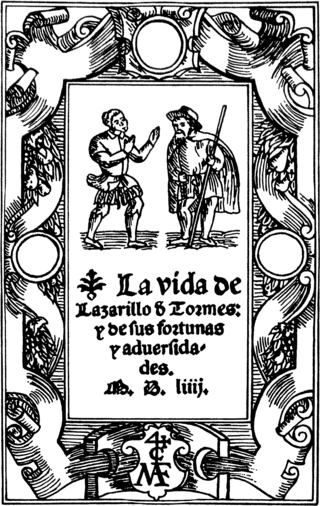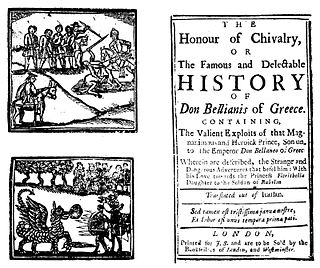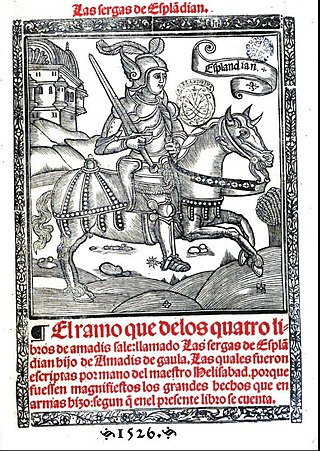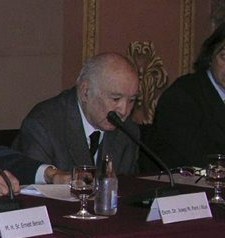
Don Quixote, the full title being The Ingenious Gentleman Don Quixote of La Mancha, is a Spanish novel by Miguel de Cervantes. It was originally published in two parts, in 1605 and 1615. Considered a founding work of Western literature, it is often labelled as the first modern novel. Don Quixote is also one of the most-translated books in the world and one of the best-selling novels of all time.

Amadís de Gaula is an Iberian landmark work among the Spanish and Portuguese chivalric romances which were in vogue in the 16th century, although its first version, much revised before printing, was written at the onset of the 14th century in an uncertain place of the Iberian Peninsula.

The Life of Lazarillo de Tormes and of His Fortunes and Adversities is a Spanish novella, published anonymously because of its anticlerical content. It was published simultaneously in three cities in 1554: Alcalá de Henares, Burgos and Antwerp. The Alcalá de Henares edition adds some episodes which were most likely written by a second author. It is most famous as the book establishing the style of the picaresque satirical novel.

A knight-errant is a figure of medieval chivalric romance literature. The adjective errant indicates how the knight-errant would wander the land in search of adventures to prove his chivalric virtues, either in knightly duels or in some other pursuit of courtly love.

Garci Rodríguez de Montalvo was a Castilian author who arranged the modern version of the chivalric romance Amadís de Gaula, originally written in three books in the 14th century by an unknown author. Montalvo incorporated a fourth book in the original series, and followed it with a sequel, Las sergas de Esplandián. It is the sequel that Montalvo is most often noted for, mainly because within the book he coined the word California.

Rocinante (Rozinante) is Don Quixote's horse in the 1605/1615 novel Don Quixote by Miguel de Cervantes. In many ways, Rozinante is not only Don Quixote's horse, but also his double; like Don Quixote, he is awkward, past his prime, and engaged in a task beyond his capacities.

Belianís of Greece is the eponymous hero of a Spanish chivalric romance novel, The honour of chivalry, following in the footsteps of the influential Amadis de Gaula. An English abridgement of this novel was published in 1673. It is best known today because it was one of the books spared during the expurgation of Don Quixote's library in Chapter 6 of Part I of Don Quixote.

As a literary genre, the chivalric romance is a type of prose and verse narrative that was popular in the noble courts of high medieval and early modern Europe. They were fantastic stories about marvel-filled adventures, often of a chivalric knight-errant portrayed as having heroic qualities, who goes on a quest. It developed further from the epics as time went on; in particular, "the emphasis on love and courtly manners distinguishes it from the chanson de geste and other kinds of epic, in which masculine military heroism predominates."

Alonso Fernández de Avellaneda is the pseudonym of a man who wrote a sequel to Cervantes' Don Quixote, before Cervantes finished and published his own second volume.

Henry of Castile, called the Senator, was a Castilian infante, the fourth son of Ferdinand III of Castile by his first wife, Beatrice of Swabia.
Feliciano de Silva was a Spanish writer. Born in Ciudad Rodrigo to a powerful family, Silva wrote “sequels” to La Celestina and Amadis de Gaula. A prolific writer, his first chivalresque work, Lisurate de Grecia, was published in 1514. It is a relatively short work. His Amadis of Greece (1530) continued the success enjoyed by this first work. Amadis of Greece is divided into two parts which deal with the adventures of Amadis of Greece, Knight of the Burning Sword, son of Lisuarte of Greece and Onoloria of Trabizond (Trapisonda), as well as his love for both Princess Lucela of France and Princess Niquea of Thebes, whom he subsequently marries.

Amadigi di Gaula is a "magic" opera in three acts, with music by George Frideric Handel. It was the fifth Italian opera that Handel wrote for an English theatre and the second he wrote for Richard Boyle, 3rd Earl of Burlington in 1715. The opera about a damsel in distress is based on Amadis de Grèce, a French tragédie-lyrique by André Cardinal Destouches and Antoine Houdar de la Motte. Amadigi was written for a small cast, employing four high voices. Handel made prominent use of wind instruments, so the score is unusually colorful, comparable to his Water Music.
Pero Ferrús was a Castilian poet. He lived in Alcalá de Henares.

Las Sergas de Esplandián is a novel written by Garci Rodríguez de Montalvo in the late fifteenth or early sixteenth century. The novel is a sequel to a popular fifteenth century set of chivalric romance novels, Amadís de Gaula. The novel achieved particular notability in 1862, when Edward Everett Hale concluded that the novel was the origin of the name California.

Cide Hamete Benengeli is a fictional Arab Muslim historian created by Miguel de Cervantes in his novel Don Quixote, who Cervantes says is the true author of most of the work. This is a skilful metafictional literary pirouette that seems to give more credibility to the text, making the reader believe that Don Quixote was a real person and the story is decades old. However, it is obvious to the reader that such a thing is impossible, and that the pretense of Cide Hamete's work is meant as a joke.

Martí de Riquer i Morera, 8th Count of Casa Dávalos was a Spanish literary historian and Romance philologist, a recognised international authority in the field. His writing career lasted from 1934 to 2004. He was also a nobleman and Grandee of Spain.

Amadis de Gaule, or Amadis des Gaules, is a French opera in three acts by the German composer Johann Christian Bach. The libretto is a revision by Alphonse de Vismes of Amadis by Philippe Quinault, originally set by Jean-Baptiste Lully in 1684, which in turn, was based on the knight-errantry romance Amadis de Gaula (1508). Bach's opera was first performed at the Académie Royale de Musique, Paris, on 14 December 1779. It followed the contemporary French fashion for resetting libretti by Quinault. The work was not a success with the Parisian public, mainly because it pleased neither the supporters of Gluck nor those of Piccinni, the two leading rival opera composers in France at the time. It was the last opera J. C. Bach composed.

Amadis de Grèce is an opera by the French composer André Cardinal Destouches, first performed at the Académie Royale de Musique on 26 March 1699. It takes the form of a tragédie en musique in a prologue and five acts. The libretto, by Antoine Houdar de La Motte, is based on the medieval romance Amadis de Gaula. La Motte's text was adapted to produce the Italian-language libretto for Handel's opera seriaAmadigi di Gaula (1715).
Lisuarte of Great Britain is a character in the Spanish chivalric romance Amadís de Gaula and its sequel Las sergas de Esplandián, a work by Garci Rodríguez de Montalvo. Lisuarte is king of Great Britain and father of the peerless Oriana, beloved of Amadís de Gaula.














